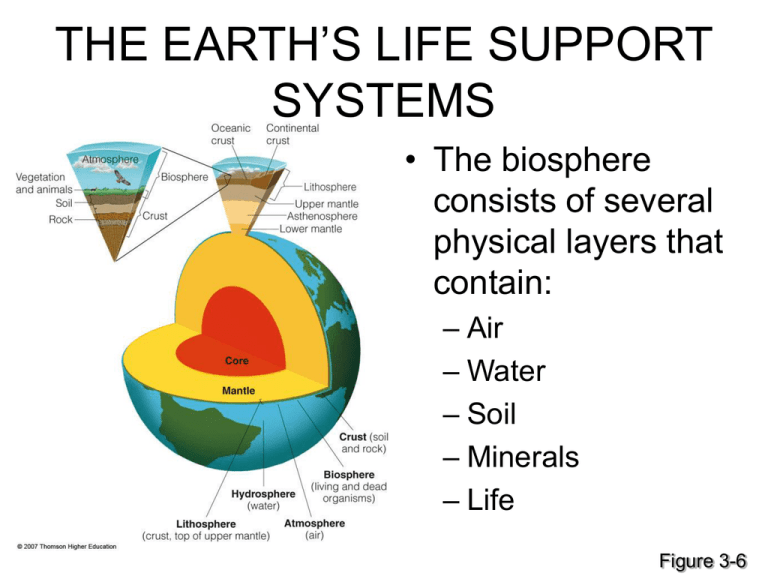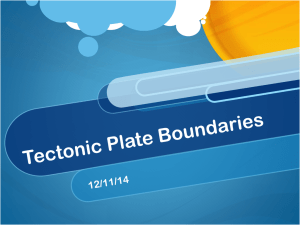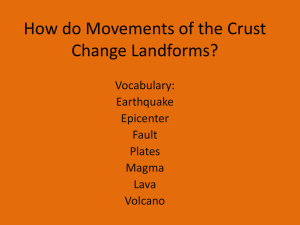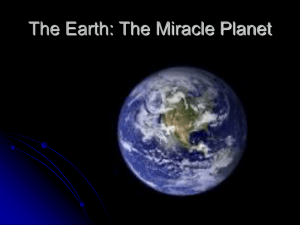THE EARTH`S LIFE SUPPORT SYSTEMS - sohs
advertisement

THE EARTH’S LIFE SUPPORT SYSTEMS • The biosphere consists of several physical layers that contain: – Air – Water – Soil – Minerals – Life Figure 3-6 Biosphere • Atmosphere – Membrane of air around the planet. • Stratosphere – Lower portion contains ozone to filter out most of the sun’s harmful UV radiation. • Hydrosphere – All the earth’s water: liquid, ice, water vapor • Lithosphere – The earth’s crust and upper mantle. GEOLOGIC PROCESSES • The earth is made up of a core, mantle, and crust and is constantly changing as a result of processes taking place on and below its surface. • The earth’s interior consists of: – Core: innermost zone with solid inner core and molten outer core that is extremely hot. – Mantle: solid rock, under which is the asthenosphere that is melted pliable rock. – Crust: Outermost zone which underlies the continents. Earth • • • • orbit: 149,600,000 km (1.00 AU) from Sun diameter: 12,756.3 km mass: 5.972e24 kg Earth’s layers (depths in km) – 0- 40 Crust – 40- 2890 Mantle – 2890-5150 Outer core – 5150-6378 Inner core Earth • Earth’s mass (measured in 10^24 kg) – atmosphere = 0.0000051 – oceans = 0.0014 – crust = 0.026 – mantle = 4.043 – outer core = 1.835 – inner core = 0.09675 Earth’s Interior • • • • Core is made up mostly of iron/nickel Temperatures in core reach 7500 K The crust is primarily quartz. Taken as a whole, the Earth's chemical composition (by mass) is: – 34.6% Iron – 29.5% Oxygen – 15.2% Silicon – 12.7% Magnesium 2.4% Nickel 1.9% Sulfur 0.05% Titanium GEOLOGIC PROCESSES • Major features of the earth’s crust and upper mantle. Figure 15-2 Volcanoes Abyssal hills Oceanic crust (lithosphere) Abyssal Oceanic floor ridge Abyssal floor Trench Folded mountain belt Abyssal plain Craton Continental shelf Continental slope Continental rise Continental crust (lithosphere) Mantle (lithosphere) Fig. 15-2, p. 336 Spreading center Collision between two continents Subduction zone Continental crust Oceanic crust Ocean trench Oceanic crust Continental crust Material cools Cold dense as it reaches material falls the outer back through mantle mantle Hot Mantle material convection rising cell through the mantle Two plates move towards each other. One is subducted back into the mantle on a falling convection current. Mantle Hot outer core Inner core Fig. 15-3, p. 337 INTERNAL GEOLOGIC PROCESSES • Huge volumes of heated and molten rack moving around the earth’s interior form massive solid plates that move extremely slowly across the earth’s surface. – Tectonic plates: huge rigid plates that are moved with convection cells or currents by floating on magma or molten rock. The Earth’s Major Tectonic Plates Figure 15-4 Major Plates • • • • • • • • North American Plate South American Plate Antarctic Plate Eurasian Plate African Plate Indian-Australian Plate Nazca Plate Pacific Plate Plate Movement • The extremely slow movements of these plates cause them to grind into one another at convergent plate boundaries, move apart at divergent plate boundaries and slide past at transform plate Figure 15-4 boundaries. Fig. 15-4, p. 338 JUAN DE FUCA PLATE EURASIAN PLATE NORTH AMERICAN PLATE ANATOLIAN PLATE CARIBBEAN PLATE ARABIAN AFRICAN PLATE PLATE PACIFIC PLATE SOUTH AMERICAN NAZCA PLATE PLATE SOMALIAN SUBPLATE CHINA SUBPLATE PHILIPPINE PLATE INDIAAUSTRALIAN PLATE ANTARCTIC PLATE Divergent plate boundaries Convergent plate boundaries Transform faults Fig. 15-4a, p. 338 Trench Volcanic island arc Craton Transform fault Lithosphere Asthenosphere Divergent plate boundaries Lithosphere Rising magma Asthenosphere Convergent plate boundaries Lithosphere Asthenosphere Transform faults Fig. 15-4b, p. 338 Animation: Plate Margins PLAY ANIMATION Convergent Plate Boundary • • • • Two plates pushed together Oceanic + Continental = Subduction Zone Oceanic + Oceanic = Trench Continental + Continental = Mountain Range Divergent Plate Boundary • Plates moves apart from one another • Oceanic plates form oceanic ridges Transform Faults • Plates slide and grind past one another along a fracture in the lithosphere Recylcing Earth’s Crust • Natural disasters like earthquakes and volcanoes occur at plate boundaries • From geologic perspective, however, there are advantages to plate movement – Forms mineral deposits and promotes and sustains life – Led to the evolution of life on Earth – Formed Earth’s primitive atmosphere and therefore climate – Rich soils Geologic Time Scale • ~4.6 billion years ago: Earth believed to have formed, hot ball of rock • 3.9 billion years ago: rainstorms • 3.5 billion years ago: oceans, first living organisms Geologic Eras • Precambrian Era: 4.6 billion years ago- 545 million years ago – 87% of Earth’s history – Prokaryotes dominated – First eukaryotes appeared ~ 1.5 billion years ago – Simple multicellular organisms in seas • Paleozoic Era: 545 million years ago – 248 million years ago – “Explosion of life” – Many types of invertebrates in shallow seas – Early: earliest vertebrates – Middle: amphibians – Later: reptiles Geologic Eras • Mesozoic Era: 248 million years ago – 65 million years ago – Triassic: mammals made first appearance – Jurassic: “age of dinosaurs” – Cretaceous: radiation of mammals and evolution of flowering plants – Plate Tectonics: continental shift • Cenozoic Era: 65 million years ago – now – Mammals flourish – Primates evolve – Extinctions affect diversity – Modern human species evolved ~200,000 years ago EXTERNAL GEOLOGIC PROCESSES • Surface processes – Based largely on energy from the sun and gravity • Tends to wear down Earth’s surface and produce a variety of landforms by the buildup of eroded sediment • Erosion • Weathering Wearing Down and Building Up the Earth’s Surface • Weathering is an external process that wears the earth’s surface down. Figure 15-6 EROSION • Process by which material is dissolved, loosened or worn away from one part of the earth’s surface and deposited in other places • Streams are most important agents of erosion MINERALS, ROCKS, AND THE ROCK CYCLE • The earth’s crust consists of solid inorganic elements and compounds called minerals that can sometimes be used as resources. – Mineral resource: is a concentration of naturally occurring material in or on the earth’s crust that can be extracted and processed into useful materials at an affordable cost. ROCK • A very slow chemical cycle recycles three types of rock found in the earth’s crust: – Sedimentary rock (sandstone, limestone). Formed from sediment of pre-existing rocks that are weathered and eroded – Metamorphic rock (slate, marble, quartzite). Formed when pre-existing rock is subjected to high temperatures or pressure – Igneous rock (granite, pumice, basalt). Formed from cooled magma at or below earth’s surface Erosion Transportation Weathering Deposition Igneous rock Granite, pumice, basalt Sedimentary rock Sandstone, limestone Heat, pressure Cooling Heat, pressure, stress Magma (molten rock) Melting Metamorphic rock Slate, marble, gneiss, quartzite Fig. 15-8, p. 343 SOIL: A RENEWABLE RESOURCE • Soil is a slowly renewed resource that provides most of the nutrients needed for plant growth and also helps purify water. – Soil formation begins when bedrock is broken down by physical, chemical and biological processes called weathering. • Mature soils, or soils that have developed over a long time are arranged in a series of horizontal layers called soil horizons. COMPONENTS OF SOIL Soil Formation: •Product of weathering •Function of parent material, climate, topography, organisms, and time Oak tree Wood sorrel Lords and ladies Fern O horizon Leaf litter Dog violet Grasses and small shrubs Earthworm Millipede Honey fungus Mole Organic debris builds up Rock fragments Moss and lichen A horizon Topsoil B horizon Subsoil Bedrock Immature soil Regolith Young soil Pseudoscorpion C horizon Mite Parent material Nematode Root system Mature soil Red Earth Mite Springtail Actinomycetes Fungus Bacteria Fig. 3-23, p. 68 Animation: Soil Profile PLAY ANIMATION Layers in Mature Soils • Infiltration: the downward movement of water through soil. • Leaching: dissolving of minerals and organic matter in upper layers carrying them to lower layers. • The soil type determines the degree of infiltration and leaching. Soil Profiles of the Principal Terrestrial Soil Types Figure 3-24 Mosaic of closely packed pebbles, boulders Weak humusmineral mixture Desert Soil (hot, dry climate) Dry, brown to reddish-brown with variable accumulations of clay, calcium and carbonate, and soluble salts Alkaline, dark, and rich in humus Clay, calcium compounds Grassland Soil semiarid climate) Fig. 3-24a, p. 69 Acidic light-colored humus Iron and aluminum compounds mixed with clay Tropical Rain Forest Soil (humid, tropical climate) Fig. 3-24b, p. 69 Forest litter leaf mold Humus-mineral mixture Light, grayishbrown, silt loam Dark brown firm clay Deciduous Forest Soil (humid, mild climate) Fig. 3-24b, p. 69 Acid litter and humus Light-colored and acidic Humus and iron and aluminum compounds Coniferous Forest Soil (humid, cold climate) Fig. 3-24b, p. 69 Soil Properties • Soils vary in the size of the particles they contain, the amount of space between these particles, and how rapidly water flows through them. Figure 3-25 Atmosphere • Thin layer of gases that surrounds the Earth • Composed of: – – – – – – – – Nitrogen Oxygen Water vapor Argon Carbon dioxide Neon Helium Other Atmosphere has changed • Early Earth’s atmosphere consisted only of methane, water vapor, ammonia and hydrogen • Photosynthesis greatly changed our atmosphere! Five Layers Troposphere • Earth’s surface to ~ 6 miles above the surface • Contains ~ 90% of atmospheric gases • Where weather occurs Stratosphere • 6 miles to about 30 miles above Earth’s surface • Air is less dense • Less turbulent air flow • Contains the ozone layer Mesosphere, Thermosphere, Exosphere • Gases become thinner and thinner • Colder and colder • Exosphere merges with outer space









